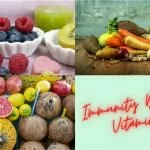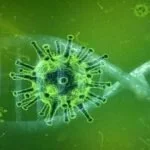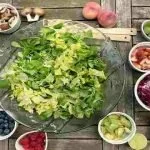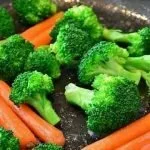What are Vitamins
Vitamins is the term used for a group of potent organic compounds other than proteins , carbohydrates and fats which occur in minute quantities in food and which are essential for some specific body functions such as regulation , maintenance , growth and protection.
It are essential accessory food factors necessary for complete normal metabolism of the energy yielding constituents of the diet and are a must for normal body growth and development.
However excess of Vitamins are needed for growing children , pregnant and lactating females and in conditions where metabolic activities are increased.
Classification of Vitamins
It are broadly classified as Fat Soluble Vitamins and Water Soluble Vitamins.
Fat Soluble Vitamins
The fat soluble are Vitamin A, D, E and K. they require fat for their absorption and can be stored in the body. If their intake is poor but body stores are ample , deficiency symptoms will not be seen immediately.
Vitamin A
It is a fat soluble and is stored in the liver after absorption other storing sites being kidneys, lungs, adrenals and gonads. It is retinal while its aldehyde form is retinue found in mammals and salt water fish. Fresh water fish has Vit. A2. In vegetables and fruits.
Functions :-
It is performs the following Functions.
- It maintains normal vision in dim light.
- It helps in synthesis and maintenance of healthy epithelium-outermost lining of skin and innermost lining of mucous membranes of respiratory and genitourinary tract.
- It is required for normal bone and tooth development and proper growth
- It helps the body to fight against infections by keeping mucous membranes in healthy condition which act as a barrier to infection.
Deficiency
- Night blindness
- Epithelial changes
- Faulty bone modeling results in retarded bone growth in children particularly those of skull and vertebrae.
- There is hyperkeratosis of the skin.
- There is tendency to formation of renal phosphatic calculi.
Source
Milk , fats of animal origin, cod liver oil, eggs, Carrots , green leaves, butter , cream , fruits etc.
Vitamin D
It is a fat soluble. The two important forms are Vitamin D2 and Vitamin D3. Vit. D3 is produced when 7-dehydro cholesterol in the skin is exposed to the UV rays in the Sun. Vit. D differs from other fat-soluble because it is synthesized in the body and we do not depend on our diet for it. Being fat soluble , it requires fat for its absorption.
Functions
- Absorption of calcium and phosphorus from the small intestine requires the presence of Vit. D and the hormones of the parathyroid and thyroid gland.
- Mineralization of bones and teeth. After calcium and phosphorus is absorbed , Vit. D is required to ensure that these minerals are deposited in bones and teeth to strengthen them.
- Regulation of calcium and phosphorus levels in blood.
Sources
Sunlight is the main source of Vit. D. the precursor in skin is converted to active Vit. D3. it is found in fish liver oils , fortified milk , vanaspati and margarine. Natural foods such as butter , milk and fish have it in small amounts.
Deficiency
Vitamin D deficiency leads to lowered absorption of calcium , low serum levels of calcium and reduced bone mineralization. Bones cannot withstand the weight and bend into deformities.
Rickets is seen in infants and children especially dark skinned children. Bones are soft and yield to pressure. Joints are enlarged and there is delayed closing of the skull bones. Symptoms of rickets include enlarged skull , pigeon chest , poor muscle development , pot belly and bowed legs or knocked knees.
Osteomalacia or adult rickets is more common in women who consume a diet deficient in calcium , phosphorous and Vitamin D and have had several pregnancies.
Vitamin E
It is a fat-soluble Vitamin. It is stable to heat and acids. It is rapidly oxidized in rancid fats. Many clams are being made that supplements of this Vitamin. Can prevent or cure a wide variety of diseases from reproductive function to skin problems such as psoriasis and acne but there is no proof.
Function
It is associated with metabolism of muscles and is concerned with certain processes of sterility and death of fetus in utero.
Deficiency
Deficiency symptoms in human beings have not been seen. In animals the deficiency causes sterility and death of fetus in utero.
Source
- Milk
- Wheat germ oil
- Lettuce and Green vegetable
- Nuts
Vitamin K
It is essential in the diet because it is needed for synthesis of prothrombin and other blood clotting factors. It exists as K1 (found in plants) , K2 (synthesized by bacteria in the intestinal tract) and K3 (synthetic form). Being fat soluble Vitamin , it requires fat and bile salts for efficient absorption.
Function
It is required for the formation of prothrombin and several other proteins involved in clotting of blood. The ability of blood to clot is dependent upon a high blood level of prothrombin.
Deficiency
It is uncommon in adults. New born infants have sterile intestinal tract , hence they are given a single dose of Vitamin K to prevent haemorrhagic disease.
Source
- Alfa alfa
- Spinach
- Cauliflower
- Cabbage






GOOD POST
I think this is among the most significant information for me. And i’m glad reading your article. But should remark on some general things, The site style is ideal, the articles is really excellent : D. Good job, cheers